Newly Launched - AI Presentation Maker

Researched by Consultants from Top-Tier Management Companies
AI PPT Maker
Powerpoint Templates
PPT Bundles
Kpi Dashboard
Professional
Business Plans
Swot Analysis
Gantt Chart
Business Proposal
Marketing Plan
Project Management
Business Case
Business Model
Cyber Security
Business PPT
Digital Marketing
Digital Transformation
Human Resources
Product Management
Artificial Intelligence
Company Profile
Acknowledgement PPT
PPT Presentation
Reports Brochures
One Page Pitch
Interview PPT
All Categories

Top 5 Research Timeline Samples with Templates and Examples

Ashima Monga
When it comes to doing a thesis, project report, or dissertation, you spend lots of time doing research through case studies. It, however, always works best if you planned everything in a given timeline. Thus, a research timeline template is beneficial for writing a research report or project presentation for sponsors or investors.
To address this pain point of business, SlideTech offers you invaluable help in building innovative research timeline templates that give you the outline to create perfect project reports, add or remove new tasks and milestones, and change the deliverable dates of your project with a few clicks. Our templates provide an overview of the project plan’s events, highlight important points in time, break down the project’s agenda and distill important information about your products or services, etc.
In this blog, we are introducing our top-notch research timeline templates that are perfect for telling stories and visualizing the processes of your project.
Template 1: Projected Research Timeline Milestone PPT PowerPoint Presentation Ideas Backgrounds
If you need to learn how to make a research document and set schedule activities for each step, then use this fantastic research template that encompasses the content of a well-maintained research paper. Organize your activities and map meetings according to project milestones with this expert-curated template. For instance, use this template to mark out when your ‘reading and research starts and mark it as task 1, with the color-coded legend. Then task 2 could be topic presenting that starts, as soon as task 1 ends. Then, topic interpreting can be task 3 with the same start as the work on the topic started. This editable template lets you change font styles and color themes with a few clicks.
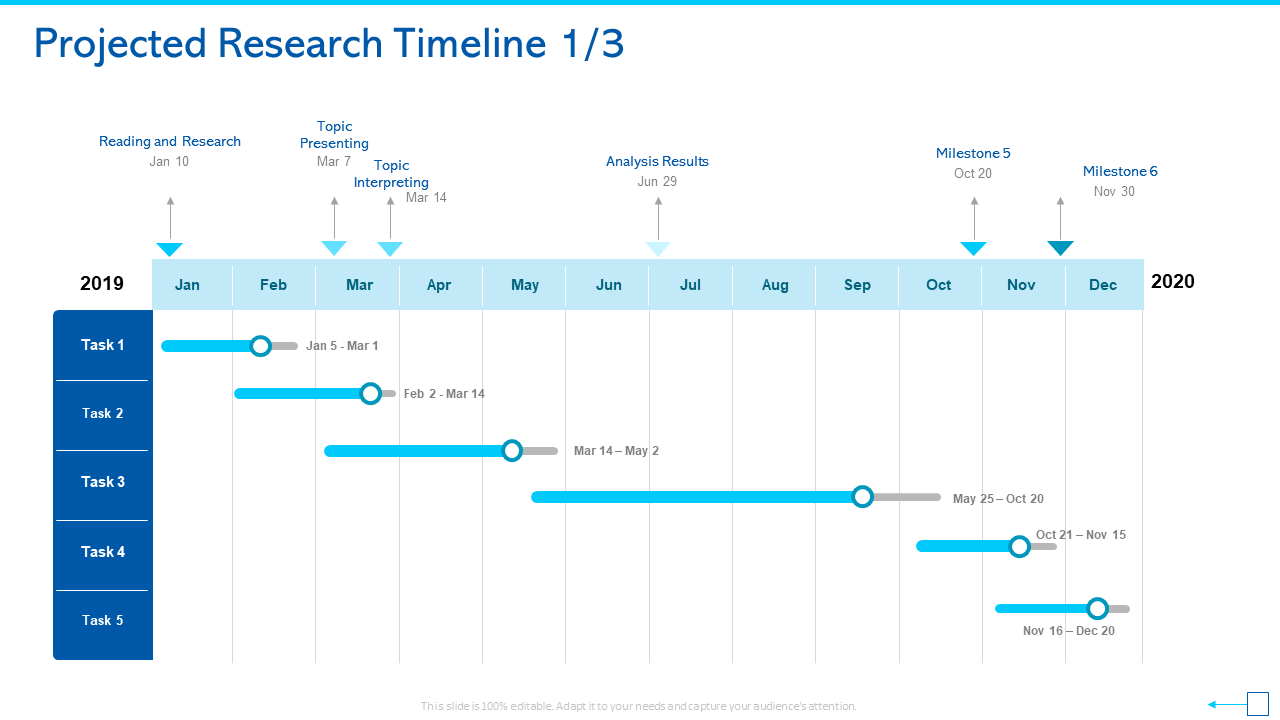
Download Now!
Template 2: Projected Research Timeline Elements PPT Presentation Infographic Template Skills
When you introduce your new products and services to the customers, get this template where steps are needed to analyze, plan, design, implement, and evaluate a specific product. Adapt this PPT Template to give a comprehensive overview of your products to target audience that you value. This handy template design guides your project from inception to completion dividing your project research tasks into Elements, Tasks and Actions.
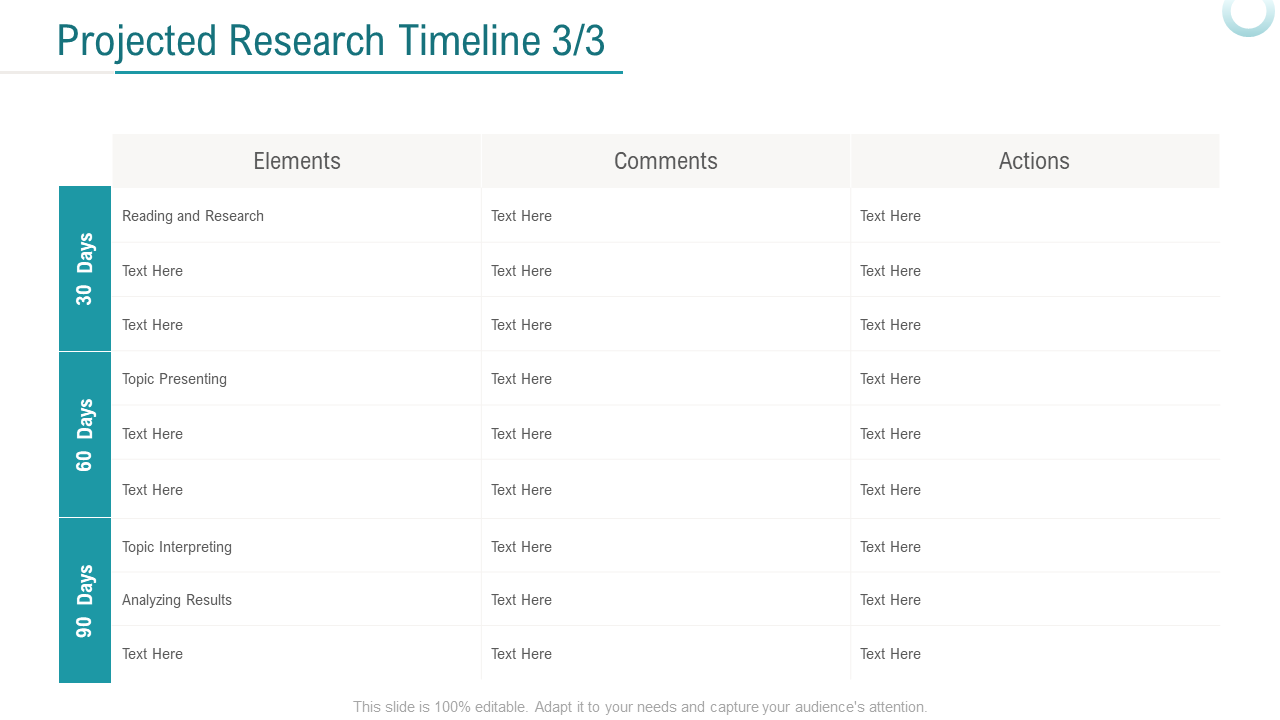
Template 3: Projected Research Timeline Planning PowerPoint Presentation Icon Backgrounds
Manage your planning with this PPT Template design to complete your project research, enlist tasks or activities with its deadline. You can measure the activities you planned through it by going to the timetable you set and evaluating the work progress. Business owners can easily visualize data with customizable maps, widgets, graphs, and charts. The phases are also listed out in detail in this template.
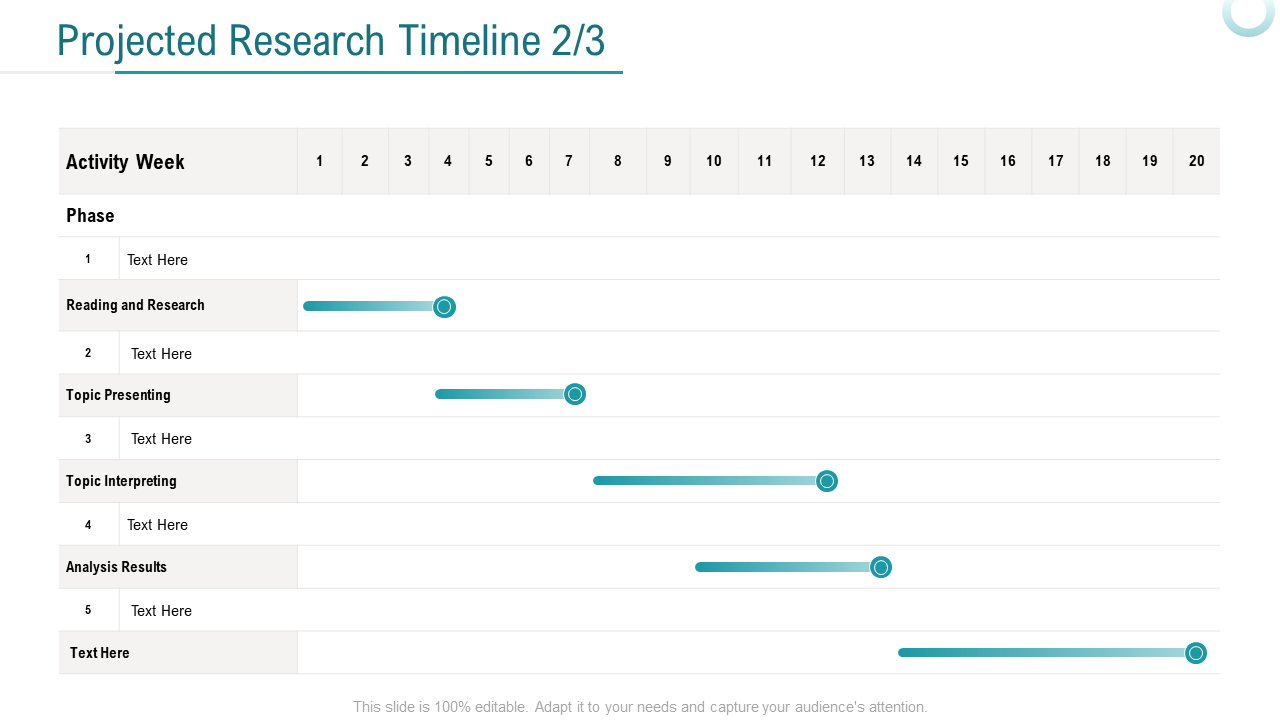
Template 4: Dissertation Projected Research Timeline Analysis PPT PowerPoint Presentation Professional
Fashionably present your research project through this ready-made Presentation Template and keep track of project deadlines. This goal- oriented template breaks down your project’s events or tasks in chronological order, giving a high-level view of the project's planning and reflecting your business plan. Use color hues for each task that differentiate each task from others on the timeline, schedule prioritize tasks, and make information more visual.
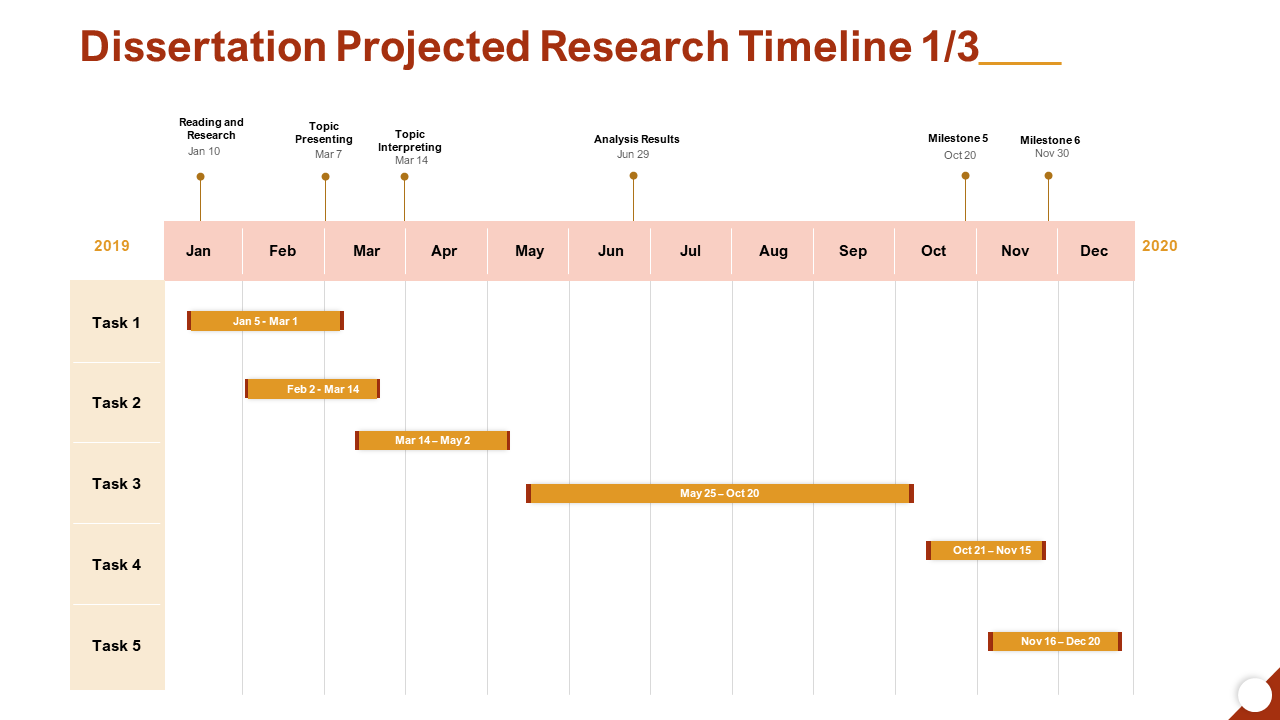
Template 5: Dissertation Projected Research Timeline Research PPT PowerPoint Presentation Topics
Grab this research timeline to illustrate and represent roadmaps for your project and highlight the planning process’s goals and tasks over a specific period. Color-coding of this template makes your design more readable, differentiating tasks, defining specific daily, weekly, or monthly activities, etc. The project manager can visualize processes and their status quo and also create natural flow of information among team members.
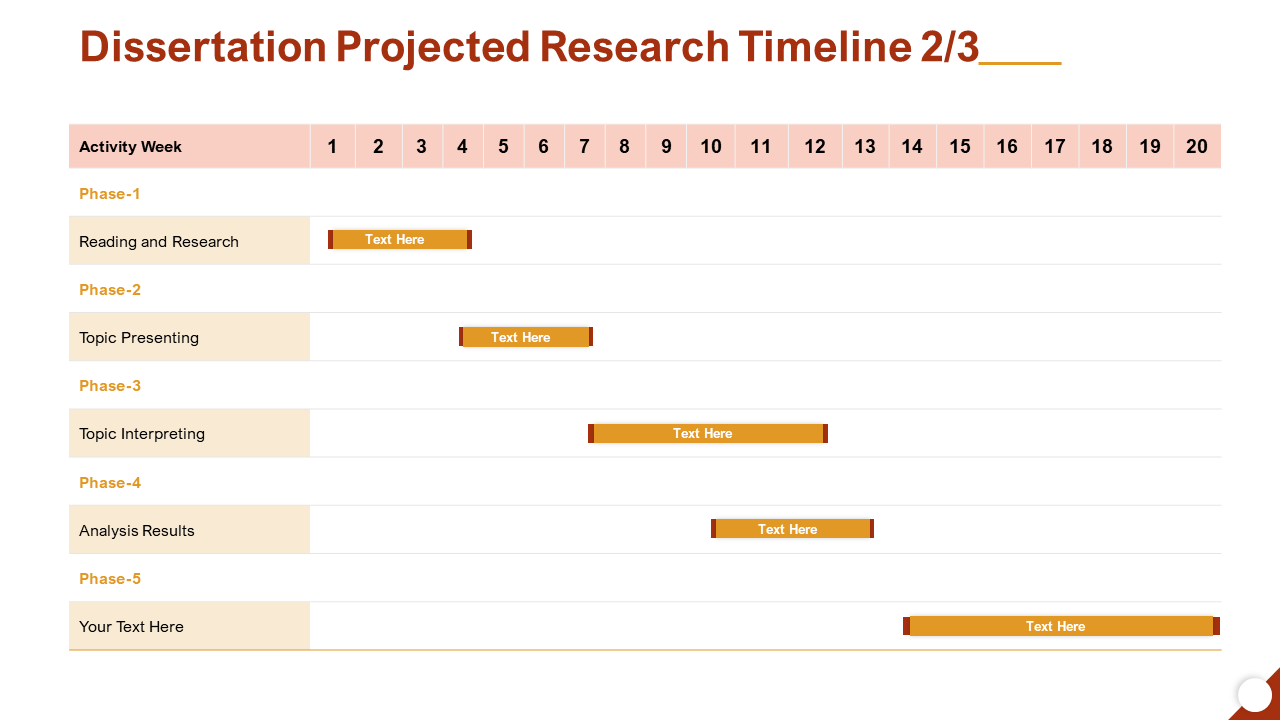
The Final Word
Running a business smoothly is a very tricky job and sometimes may be hard to manage. Our beautifully crafted research timeline templates provide the most solid foundation that builds something genuinely remarkable for your business that will captivate your audience, stakeholders, investors, etc. Our research timeline templates communicate the business’s core message clearly and emphasizes timely project delivery to your potential customers. You can always modify our templates to fit your business’s needs.
FAQs on Research Timeline
What is a research timeline.
A research timeline is an essential part of any project proposal. It defines the chronological order of events of your project plan that includes aspects such as reading & research, analysis results, milestones, preliminary data results, literature review results, etc. It gives a broad overview of your project’s planned activities at a glance.
How do you write a research timeline?
Writing a research document for any project comes with levels of complexity. You must follow some guidelines while writing a research timeline to keep yourself on track. Write the research timeline of the project in stages and give enough time to complete every step of your work.
- Define research ideas, objectives, and resources and then prepare the research proposal.
- Develop a research design for it
- Capture relevant information to create a sampling plan
- Carry out data collection to write it up
- Prepare data for analysis and draw conclusions or recommendations
- Write the final draft of the application.
- Again, review it and edit it if required and submit the final research proposal.
How long should a research timeline be?
A research timeline project can be eight weeks, six months, one year, two years, three years, or more, depending on the requirement of the project proposal. But it would help if you remembered to complete it timely while planning these periods.
How do you write a PhD research timeline?
A PhD Research Timeline is a challenging process that spans across years. Sometimes, researchers can feel quite overwhelmed. Some tips for writing a perfect PhD research timeline are:
- Decide what elements like data collection, fieldwork, experiments, data analysis, writing plan, conferences, publications, coursework, etc., you must include in your PhD research timeline.
- Share or discuss your ideas and thoughts with your guide or PhD supervisor and get their views. Note the discussion points during the meeting and edit your provisional PhD research timeline, accordingly.
- Think about the design of your PhD research timeline and prepare it across tasks and milestones.
- Track your tasks and update your PhD research timeline to prioritize tasks and set achievable and concrete goals when needed.
Related posts:
- [Updated 2023] Top 35 Timeline And Milestone Templates for Clearly Visualizing A Project’s Progress
- Top 10 Product Launch Timeline Template with Examples and Samples
- Top 10 Visual Timeline Templates with Examples and Samples
- Top 10 Personal Timeline Templates with Examples and Samples
Liked this blog? Please recommend us

Top 5 Strategic Roadmap Timeline Template with Examples and Samples
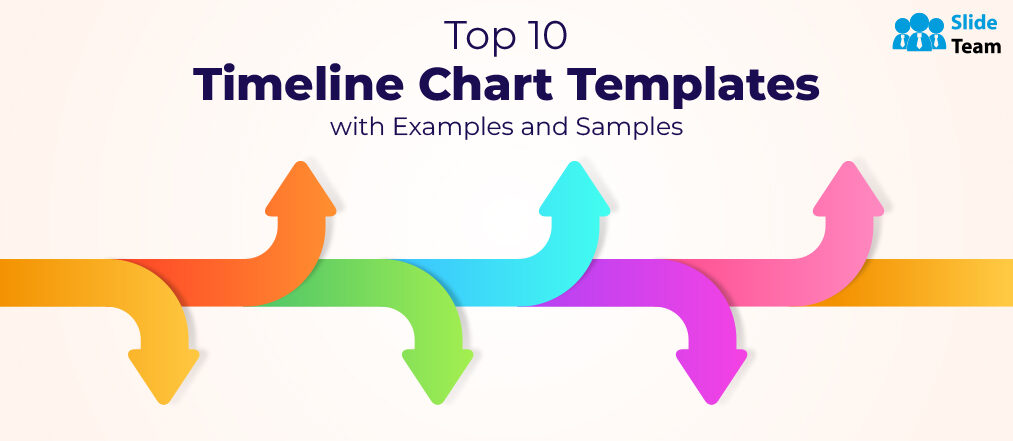
Top 10 Timeline Chart Template With Examples and Samples
This form is protected by reCAPTCHA - the Google Privacy Policy and Terms of Service apply.

- Thesis Action Plan New
- Academic Project Planner
Literature Navigator
Thesis dialogue blueprint, writing wizard's template, research proposal compass.
- See Success Stories
- Access Free Resources
- Why we are different
- All Products
- Coming Soon
Creating a Research Proposal Timeline: Examples and Best Practices

Creating a research proposal timeline is essential for managing your project efficiently. A well-planned timeline helps you stay on track, meet deadlines, and allocate resources effectively. This article will guide you through the key components, best practices, and common pitfalls to avoid when creating your research proposal timeline.
Key Takeaways
- A research proposal timeline is crucial for keeping your project organized and on schedule.
- Identifying major milestones and allocating time for each phase ensures a smooth workflow.
- Incorporating flexibility in your timeline helps you adapt to unexpected changes.
- Using templates and examples can simplify the process of creating a timeline.
- Understanding funder requirements and aligning your timeline accordingly can increase your chances of securing funding.
Understanding the Importance of a Research Proposal Timeline
Creating a research proposal timeline is crucial for the success of your project. It helps you stay organized and ensures that you meet all necessary deadlines. A well-structured timeline can make the difference between a smooth research process and one filled with stress and last-minute rushes.
Key Components of an Effective Research Proposal Timeline
Creating a research proposal timeline involves several key components that ensure your project is well-organized and feasible. Identifying major milestones is the first step. These milestones are the significant points in your research where you achieve critical objectives. For example, completing your literature review or collecting data are major milestones that should be clearly marked on your timeline.
Allocating time for each phase is crucial. You need to realistically outline the time needed to properly execute each supporting phase of research and implementation. Consider the complexity of your project and the time required for each task. This will help you avoid common pitfalls like underestimating the time needed for data analysis or writing.
Incorporating flexibility into your timeline is also important. Unexpected delays can occur, and having a buffer can save you from missing deadlines. A well-structured timeline should include additional time for achieving each milestone in case any changes or unexpected delays arise. This ensures that your proposal is judged on the quality of its planning and feasibility.
Utilizing Research Proposal Examples and Templates
Exploring visme's research proposal examples.
Visme offers a variety of research proposal examples that can help you get started. These examples cover different fields and topics, making it easier to find one that matches your needs. Using these examples can save you time and provide a solid foundation for your own proposal.
Customizing Templates to Fit Your Needs
One of the best features of Visme's templates is their flexibility. You can easily customize them to fit your specific research question and objectives. This means you can adjust the layout, text, and design elements to create a proposal that truly represents your project.
Advantages of Using Proposal Makers
Using a proposal maker like Visme has several benefits. First, it simplifies the process of creating a research proposal by providing pre-designed templates. Second, it ensures that your proposal is well-organized and visually appealing. Finally, it allows you to focus more on the content and less on the formatting, which is crucial for a successful research proposal.
Strategies for Creating a Realistic Research Schedule
Creating a realistic research schedule is crucial for balancing achievements in your bachelor thesis and special occasions . It ensures that you can manage your time effectively and meet your goals without unnecessary stress. Here are some strategies to help you create a practical and achievable research schedule.
Integrating Budget Considerations into Your Timeline
When planning your research proposal, it's crucial to align your budget with your timeline. This ensures that both elements tell the same story, adding detail and context to your project description. Maximizing resources is key to a successful research project, and this involves smart budgeting and effective resource allocation.
Adapting Your Timeline for Funding Applications
Understanding funder requirements.
When applying for funding, it's crucial to understand the specific requirements of the funder. Each funding organization may have unique criteria and expectations. Researching these requirements thoroughly will help you tailor your timeline to meet their needs. This step ensures that your proposal aligns with the funder's goals and increases your chances of success.
Meeting Strict Deadlines
Funding applications often come with strict deadlines. To avoid last-minute stress, create a detailed schedule that includes all necessary tasks and their deadlines. This approach helps you stay organized and ensures that you submit your application on time. Remember, missing a deadline can result in your proposal being rejected, no matter how strong it is.
Demonstrating Feasibility and Planning
A well-structured timeline demonstrates the feasibility of your project. It shows that you have a clear plan and that you can execute it within the given timeframe. Funders want to see that you have thought through every aspect of your project and that you have a realistic plan in place. This level of detail can make your proposal stand out and increase your chances of securing funding.
Planning your timeline for funding applications can be tricky, but it's crucial for success. Don't let deadlines sneak up on you. Visit our website to discover how our step-by-step guides can help you stay on track and stress-free. Take control of your academic journey today!
Creating a research proposal timeline is a crucial step in ensuring the success of your project. By breaking down the process into manageable phases and setting realistic deadlines, you can stay organized and focused. Using templates and examples, like those offered by Visme, can provide a solid foundation and guide you through the process. Remember, the key to a successful research proposal is thorough planning and flexibility to adapt to any unforeseen challenges. With careful preparation and a well-structured timeline, you can present a compelling proposal that stands out to funders and stakeholders.
Frequently Asked Questions
What is a research proposal timeline.
A research proposal timeline is a plan that outlines the steps and time needed to complete a research project. It helps keep the project on track and ensures all tasks are finished on time.
Why is a research proposal timeline important?
A well-structured timeline helps in organizing the research process, ensuring that each phase is completed on time, and avoiding last-minute rushes. It also helps in meeting deadlines, especially for funding applications.
What are the common mistakes to avoid when creating a research proposal timeline?
Common mistakes include underestimating the time needed for each phase, not allowing extra time for unexpected delays, and failing to align the timeline with the project’s scope and complexity.
How can Visme's research proposal examples help me?
Visme's research proposal examples provide a starting point for creating engaging and well-structured proposals. You can choose a template and customize it to fit your specific needs, making the process easier and more efficient.
How do I make a realistic research schedule?
To create a realistic research schedule, assess the project’s scope and complexity, set achievable deadlines, and allow time for revisions. Make sure to include buffer time for any unexpected delays or changes.
What should I consider when integrating budget into my timeline?
When integrating budget into your timeline, estimate the costs for each phase of the project, align the budget with the timeline, and ensure you have secured the necessary funding and resources.

Discovering Statistics Using IBM SPSS Statistics: A Fun and Informative Guide

Unlocking the Power of Data: A Review of 'Essentials of Modern Business Statistics with Microsoft Excel'

Discovering Statistics Using SAS: A Comprehensive Review

How to Type Your Thesis Fast Without Compromising Quality

Looking for the Perfect Thesis Literature Review Sample? Here’s What You Should Know

Explanatory vs. Argumentative Thesis: Which Style Fits Your Paper Best?

Thesis Action Plan

- Rebels Blog
- Blog Articles
- Affiliate Program
- Terms and Conditions
- Payment and Shipping Terms
- Privacy Policy
- Return Policy
© 2024 Research Rebels, All rights reserved.
Your cart is currently empty.
How to write a research plan: Step-by-step guide
Last updated
30 January 2024
Reviewed by
Short on time? Get an AI generated summary of this article instead
Today’s businesses and institutions rely on data and analytics to inform their product and service decisions. These metrics influence how organizations stay competitive and inspire innovation. However, gathering data and insights requires carefully constructed research, and every research project needs a roadmap. This is where a research plan comes into play.
Read this step-by-step guide for writing a detailed research plan that can apply to any project, whether it’s scientific, educational, or business-related.
- What is a research plan?
A research plan is a documented overview of a project in its entirety, from end to end. It details the research efforts, participants, and methods needed, along with any anticipated results. It also outlines the project’s goals and mission, creating layers of steps to achieve those goals within a specified timeline.
Without a research plan, you and your team are flying blind, potentially wasting time and resources to pursue research without structured guidance.
The principal investigator, or PI, is responsible for facilitating the research oversight. They will create the research plan and inform team members and stakeholders of every detail relating to the project. The PI will also use the research plan to inform decision-making throughout the project.
- Why do you need a research plan?
Create a research plan before starting any official research to maximize every effort in pursuing and collecting the research data. Crucially, the plan will model the activities needed at each phase of the research project .
Like any roadmap, a research plan serves as a valuable tool providing direction for those involved in the project—both internally and externally. It will keep you and your immediate team organized and task-focused while also providing necessary definitions and timelines so you can execute your project initiatives with full understanding and transparency.
External stakeholders appreciate a working research plan because it’s a great communication tool, documenting progress and changing dynamics as they arise. Any participants of your planned research sessions will be informed about the purpose of your study, while the exercises will be based on the key messaging outlined in the official plan.
Here are some of the benefits of creating a research plan document for every project:
Project organization and structure
Well-informed participants
All stakeholders and teams align in support of the project
Clearly defined project definitions and purposes
Distractions are eliminated, prioritizing task focus
Timely management of individual task schedules and roles
Costly reworks are avoided
- What should a research plan include?
The different aspects of your research plan will depend on the nature of the project. However, most official research plan documents will include the core elements below. Each aims to define the problem statement , devising an official plan for seeking a solution.
Specific project goals and individual objectives
Ideal strategies or methods for reaching those goals
Required resources
Descriptions of the target audience, sample sizes , demographics, and scopes
Key performance indicators (KPIs)
Project background
Research and testing support
Preliminary studies and progress reporting mechanisms
Cost estimates and change order processes
Depending on the research project’s size and scope, your research plan could be brief—perhaps only a few pages of documented plans. Alternatively, it could be a fully comprehensive report. Either way, it’s an essential first step in dictating your project’s facilitation in the most efficient and effective way.
- How to write a research plan for your project
When you start writing your research plan, aim to be detailed about each step, requirement, and idea. The more time you spend curating your research plan, the more precise your research execution efforts will be.
Account for every potential scenario, and be sure to address each and every aspect of the research.
Consider following this flow to develop a great research plan for your project:
Define your project’s purpose
Start by defining your project’s purpose. Identify what your project aims to accomplish and what you are researching. Remember to use clear language.
Thinking about the project’s purpose will help you set realistic goals and inform how you divide tasks and assign responsibilities. These individual tasks will be your stepping stones to reach your overarching goal.
Additionally, you’ll want to identify the specific problem, the usability metrics needed, and the intended solutions.
Know the following three things about your project’s purpose before you outline anything else:
What you’re doing
Why you’re doing it
What you expect from it
Identify individual objectives
With your overarching project objectives in place, you can identify any individual goals or steps needed to reach those objectives. Break them down into phases or steps. You can work backward from the project goal and identify every process required to facilitate it.
Be mindful to identify each unique task so that you can assign responsibilities to various team members. At this point in your research plan development, you’ll also want to assign priority to those smaller, more manageable steps and phases that require more immediate or dedicated attention.
Select research methods
Once you have outlined your goals, objectives, steps, and tasks, it’s time to drill down on selecting research methods . You’ll want to leverage specific research strategies and processes. When you know what methods will help you reach your goals, you and your teams will have direction to perform and execute your assigned tasks.
Research methods might include any of the following:
User interviews : this is a qualitative research method where researchers engage with participants in one-on-one or group conversations. The aim is to gather insights into their experiences, preferences, and opinions to uncover patterns, trends, and data.
Field studies : this approach allows for a contextual understanding of behaviors, interactions, and processes in real-world settings. It involves the researcher immersing themselves in the field, conducting observations, interviews, or experiments to gather in-depth insights.
Card sorting : participants categorize information by sorting content cards into groups based on their perceived similarities. You might use this process to gain insights into participants’ mental models and preferences when navigating or organizing information on websites, apps, or other systems.
Focus groups : use organized discussions among select groups of participants to provide relevant views and experiences about a particular topic.
Diary studies : ask participants to record their experiences, thoughts, and activities in a diary over a specified period. This method provides a deeper understanding of user experiences, uncovers patterns, and identifies areas for improvement.
Five-second testing: participants are shown a design, such as a web page or interface, for just five seconds. They then answer questions about their initial impressions and recall, allowing you to evaluate the design’s effectiveness.
Surveys : get feedback from participant groups with structured surveys. You can use online forms, telephone interviews, or paper questionnaires to reveal trends, patterns, and correlations.
Tree testing : tree testing involves researching web assets through the lens of findability and navigability. Participants are given a textual representation of the site’s hierarchy (the “tree”) and asked to locate specific information or complete tasks by selecting paths.
Usability testing : ask participants to interact with a product, website, or application to evaluate its ease of use. This method enables you to uncover areas for improvement in digital key feature functionality by observing participants using the product.
Live website testing: research and collect analytics that outlines the design, usability, and performance efficiencies of a website in real time.
There are no limits to the number of research methods you could use within your project. Just make sure your research methods help you determine the following:
What do you plan to do with the research findings?
What decisions will this research inform? How can your stakeholders leverage the research data and results?
Recruit participants and allocate tasks
Next, identify the participants needed to complete the research and the resources required to complete the tasks. Different people will be proficient at different tasks, and having a task allocation plan will allow everything to run smoothly.
Prepare a thorough project summary
Every well-designed research plan will feature a project summary. This official summary will guide your research alongside its communications or messaging. You’ll use the summary while recruiting participants and during stakeholder meetings. It can also be useful when conducting field studies.
Ensure this summary includes all the elements of your research project . Separate the steps into an easily explainable piece of text that includes the following:
An introduction: the message you’ll deliver to participants about the interview, pre-planned questioning, and testing tasks.
Interview questions: prepare questions you intend to ask participants as part of your research study, guiding the sessions from start to finish.
An exit message: draft messaging your teams will use to conclude testing or survey sessions. These should include the next steps and express gratitude for the participant’s time.
Create a realistic timeline
While your project might already have a deadline or a results timeline in place, you’ll need to consider the time needed to execute it effectively.
Realistically outline the time needed to properly execute each supporting phase of research and implementation. And, as you evaluate the necessary schedules, be sure to include additional time for achieving each milestone in case any changes or unexpected delays arise.
For this part of your research plan, you might find it helpful to create visuals to ensure your research team and stakeholders fully understand the information.
Determine how to present your results
A research plan must also describe how you intend to present your results. Depending on the nature of your project and its goals, you might dedicate one team member (the PI) or assume responsibility for communicating the findings yourself.
In this part of the research plan, you’ll articulate how you’ll share the results. Detail any materials you’ll use, such as:
Presentations and slides
A project report booklet
A project findings pamphlet
Documents with key takeaways and statistics
Graphic visuals to support your findings
- Format your research plan
As you create your research plan, you can enjoy a little creative freedom. A plan can assume many forms, so format it how you see fit. Determine the best layout based on your specific project, intended communications, and the preferences of your teams and stakeholders.
Find format inspiration among the following layouts:
Written outlines
Narrative storytelling
Visual mapping
Graphic timelines
Remember, the research plan format you choose will be subject to change and adaptation as your research and findings unfold. However, your final format should ideally outline questions, problems, opportunities, and expectations.
- Research plan example
Imagine you’ve been tasked with finding out how to get more customers to order takeout from an online food delivery platform. The goal is to improve satisfaction and retain existing customers. You set out to discover why more people aren’t ordering and what it is they do want to order or experience.
You identify the need for a research project that helps you understand what drives customer loyalty . But before you jump in and start calling past customers, you need to develop a research plan—the roadmap that provides focus, clarity, and realistic details to the project.
Here��’s an example outline of a research plan you might put together:
Project title
Project members involved in the research plan
Purpose of the project (provide a summary of the research plan’s intent)
Objective 1 (provide a short description for each objective)
Objective 2
Objective 3
Proposed timeline
Audience (detail the group you want to research, such as customers or non-customers)
Budget (how much you think it might cost to do the research)
Risk factors/contingencies (any potential risk factors that may impact the project’s success)
Remember, your research plan doesn’t have to reinvent the wheel—it just needs to fit your project’s unique needs and aims.
Customizing a research plan template
Some companies offer research plan templates to help get you started. However, it may make more sense to develop your own customized plan template. Be sure to include the core elements of a great research plan with your template layout, including the following:
Introductions to participants and stakeholders
Background problems and needs statement
Significance, ethics, and purpose
Research methods, questions, and designs
Preliminary beliefs and expectations
Implications and intended outcomes
Realistic timelines for each phase
Conclusion and presentations
How many pages should a research plan be?
Generally, a research plan can vary in length between 500 to 1,500 words. This is roughly three pages of content. More substantial projects will be 2,000 to 3,500 words, taking up four to seven pages of planning documents.
What is the difference between a research plan and a research proposal?
A research plan is a roadmap to success for research teams. A research proposal, on the other hand, is a dissertation aimed at convincing or earning the support of others. Both are relevant in creating a guide to follow to complete a project goal.
What are the seven steps to developing a research plan?
While each research project is different, it’s best to follow these seven general steps to create your research plan:
Defining the problem
Identifying goals
Choosing research methods
Recruiting participants
Preparing the brief or summary
Establishing task timelines
Defining how you will present the findings
Should you be using a customer insights hub?
Do you want to discover previous research faster?
Do you share your research findings with others?
Do you analyze research data?
Start for free today, add your research, and get to key insights faster
Editor’s picks
Last updated: 18 April 2023
Last updated: 27 February 2023
Last updated: 22 August 2024
Last updated: 30 September 2024
Last updated: 16 August 2024
Last updated: 9 March 2023
Last updated: 30 April 2024
Last updated: 12 December 2023
Last updated: 11 March 2024
Last updated: 4 July 2024
Last updated: 6 March 2024
Last updated: 5 March 2024
Last updated: 13 May 2024
Latest articles
Related topics, decide what to build next, log in or sign up.
Get started for free
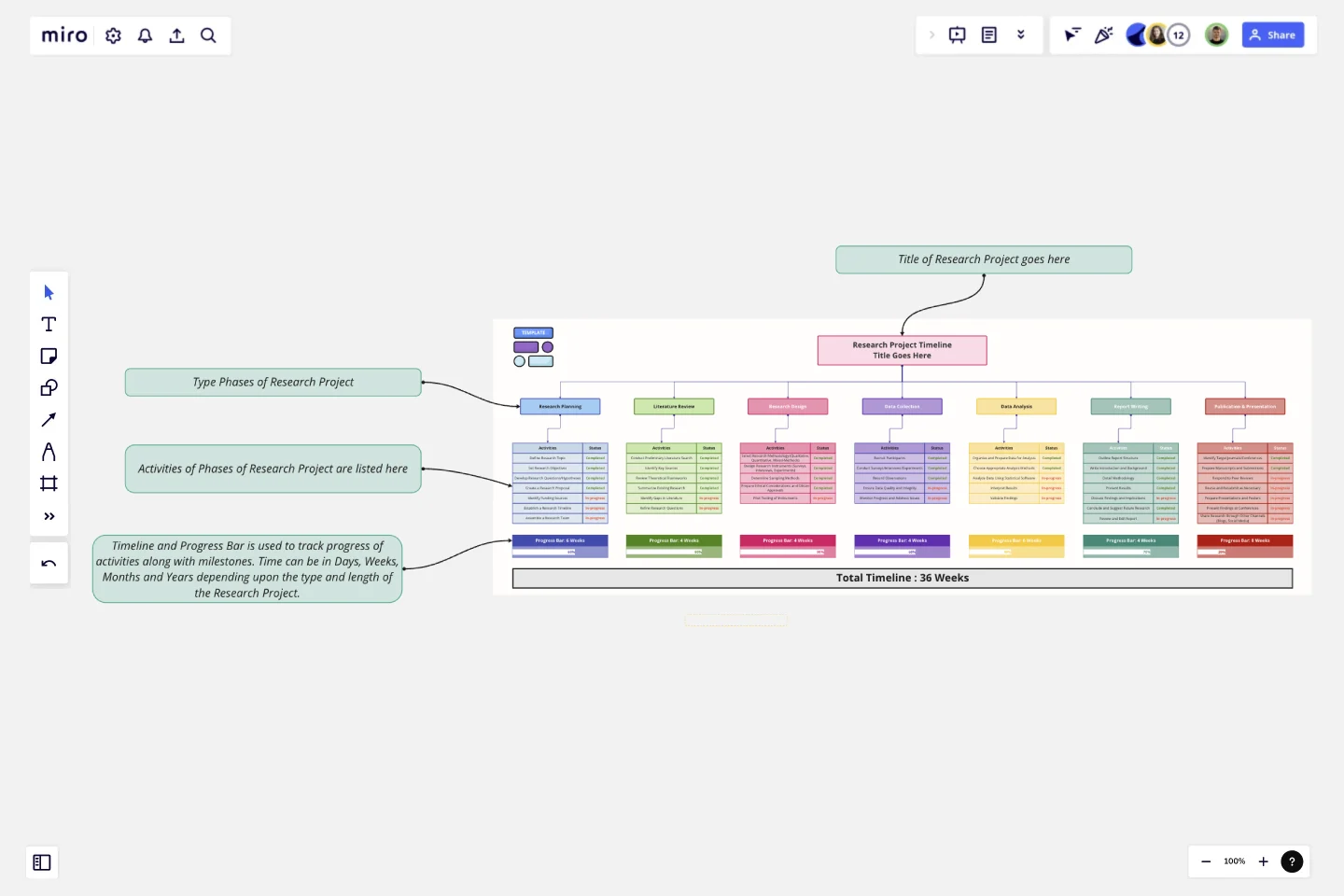
Research Project Timeline
The "Effective Research Timeline" template is designed to guide researchers through the various stages of conducting a comprehensive research project.
Whether you are a seasoned academic, a postgraduate student, or a professional conducting market or scientific research, this template helps you organize, plan, and track your research activities from start to finish.
Key Features:
Structured Phases: The template breaks down the research process into seven distinct phases: Research Planning, Literature Review, Research Design, Data Collection, Data Analysis, Report Writing, and Publication & Presentation.
Detailed Activities: Each phase includes a list of specific activities with checkboxes to track progress, ensuring no critical steps are overlooked.
Visual Timeline: A visually appealing timeline with color-coded sections for each phase, making it easy to follow and update.
Milestones and Deadlines: Key milestones and deadlines are highlighted to keep the project on track and ensure timely completion.
Collaborative Tools: Interactive elements allow team members to add comments, updates, and collaborate efficiently.
How to Use:
Start with Research Planning: Define your research topic, set objectives, develop research questions, and create a detailed research proposal. Assemble your research team and establish a timeline for the project.
Conduct a Literature Review: Perform a thorough review of existing research, identify key sources, summarize findings, and refine your research questions based on the gaps identified in the literature.
Design Your Research: Choose the appropriate methodology, design your research instruments, and prepare for ethical considerations. Pilot test your instruments to ensure their effectiveness.
Collect Data: Recruit participants, conduct surveys and interviews, record observations, and ensure data quality and integrity throughout the collection process.
Analyze Data: Organize and prepare data for analysis, choose suitable analysis methods, interpret results, and validate your findings to ensure accuracy.
Write the Report: Outline the structure of your report, write the introduction, methodology, results, and discussion sections, and review and edit the report for clarity and coherence.
Publish and Present: Identify target journals and conferences, prepare manuscripts and submissions, respond to peer reviews, and revise as necessary. Prepare presentations and share your findings through various channels.
This template was created by Khawaja Rizwan .
Get started with this template right now.

Event Planning Timeline
Works best for:.
Organizing an event involves numerous tasks and tight deadlines. The Event Planning Timeline template simplifies this process. Use it to plan and track every aspect of your event, from initial brainstorming to final execution. Assign tasks, set deadlines, and monitor progress to ensure smooth operations. Whether for small gatherings or large conferences, this template helps manage logistics and coordination.

History Timeline
The History Timeline template is perfect for visualizing historical events in a structured and engaging way. Whether you're a teacher, student, or history enthusiast, this template helps you chronologically organize significant events, eras, and milestones. Customize it to highlight key moments, add detailed descriptions, and even include images for a richer experience, making history presentations captivating.

Marketing Campaign Timeline
Timeline, Planning
Plan and execute your marketing strategies seamlessly with the Marketing Campaign Timeline template. This tool allows you to map out every stage of your campaign, from planning to launch and analysis. Visualize key milestones, set deadlines, and track progress to ensure your marketing efforts are well-coordinated and effective. Ideal for marketing teams looking to optimize their campaign management.
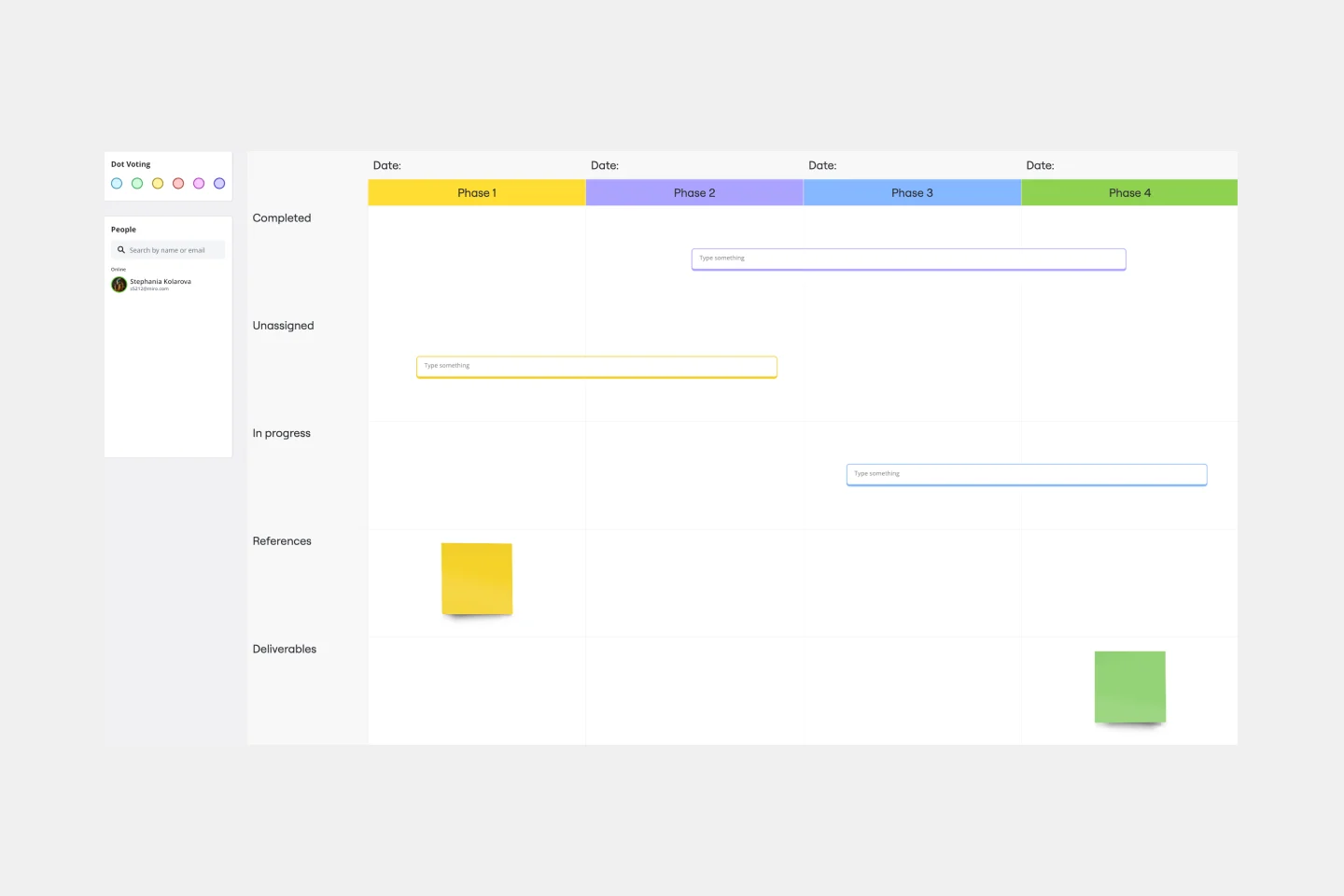
Timeline Workflow
Project Management, Flowcharts, Operations
A timeline is a visual tool that chronologically plots out projects step by step. It’s an ideal tool for your team to tell stories (such as an overview of events in your organization) and visualize your projects or processes. The Timeline Workflow template is perfect for any project that relies on visual content. You may find it beneficial to use with your team and also to share with other stakeholders or clients to keep them in the loop on your progress.
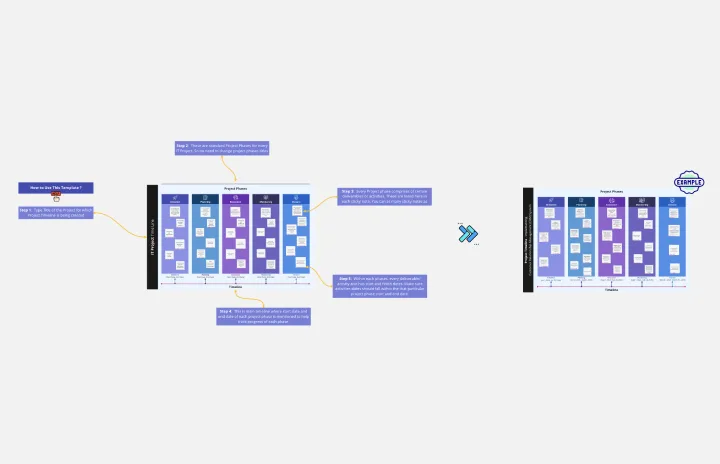
IT Project Timeline
The IT Project Time Line template is essential for managing IT projects efficiently. It allows you to visualize project milestones, deadlines, and key tasks in a clear, chronological format. Track progress, allocate resources, and ensure timely delivery of your IT projects. Ideal for project managers and IT teams aiming to stay organized and meet critical deadlines.
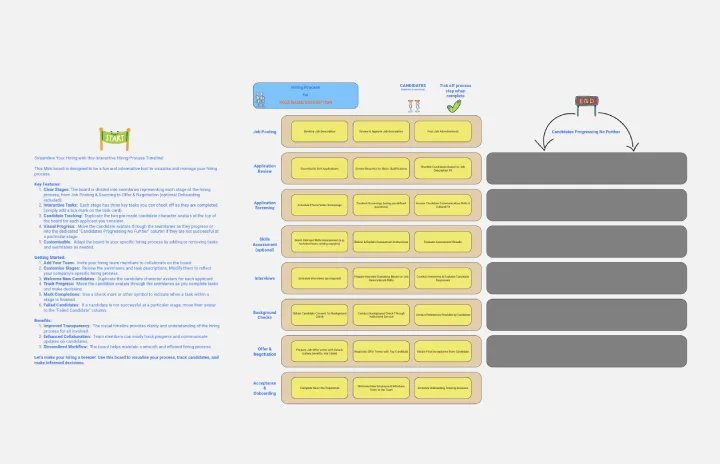
Hiring Process Timeline
Simplify your hiring process with the Hiring Process Timeline template. This tool helps you map out each step of your recruitment process, from job posting to onboarding. Visualize deadlines, track candidate progress, and ensure a smooth and efficient hiring experience. Perfect for HR teams looking to streamline and enhance their recruitment strategy.
- Humanities ›
- Writing Research Papers ›
How to Develop a Research Paper Timeline
- Writing Research Papers
- Writing Essays
- English Grammar
- M.Ed., Education Administration, University of Georgia
- B.A., History, Armstrong State University
Research papers come in many sizes and levels of complexity. There is no single set of rules that fits every project, but there are guidelines you should follow to keep yourself on track throughout the weeks as you prepare, research, and write. You will complete your project in stages, so you must plan ahead and give yourself enough time to complete every stage of your work.
Your first step is to write down the due date for your paper on a big wall calendar , in your planner , and in an electronic calendar.
Plan backward from that due date to determine when you should have your library work completed. A good rule of thumb is to spend:
- Fifty percent of your time researching and reading
- Ten percent of your time sorting and marking your research
- Forty percent of your time writing and formatting
Timeline for Researching and Reading Stage
- 1 week for short papers with one or two sources
- 2-3 weeks for papers up to ten pages
- 2-3 months for a thesis
It’s important to get started right away on the first stage. In a perfect world, we would find all of the sources we need to write our paper in our nearby library. In the real world, however, we conduct internet queries and discover a few perfect books and articles that are absolutely essential to our topic—only to find that they are not available at the local library.
The good news is that you can still get the resources through an interlibrary loan. But that will take time. This is one good reason to do a thorough search early on with the help of a reference librarian .
Give yourself time to collect many possible resources for your project. You will soon find that some of the books and articles you choose don’t actually offer any useful information for your particular topic. You’ll need to make a few trips to the library. You won’t finish in one trip.
You’ll also discover that you will find additional potential sources in the bibliographies of your first selections. Sometimes the most time-consuming task is eliminating potential sources.
Timeline for Sorting and Marking Your Research
- 1 day for a short paper
- 3-5 days for papers up to ten pages
- 2-3 weeks for a thesis
You should read each of your sources at least twice. Read your sources the first time to soak in some information and to make notes on research cards.
Read your sources a second time more quickly, skimming through the chapters and putting sticky note flags on pages that contain important points or pages that contain passages that you want to cite. Write keywords on the sticky note flags.
Timeline for Writing and Formatting
- Four days for a short paper with one or two sources
- 1-2 weeks for papers up to ten pages
- 1-3 months for a thesis
You don’t really expect to write a good paper on your first attempt, do you?
You can expect to pre-write, write, and rewrite several drafts of your paper. You’ll also have to rewrite your thesis statement a few times, as your paper takes shape.
Don’t get held up writing any section of your paper—especially the introductory paragraph. It is perfectly normal for writers to go back and complete the introduction once the rest of the paper is completed.
The first few drafts don’t have to have perfect citations. Once you begin to sharpen your work and you’re heading toward a final draft, you should tighten your citations. Use a sample essay if you need to, just to get the formatting down.
Make sure your bibliography contains every source you’ve used in your research.
- How to Write a 10-Page Research Paper
- How to Narrow the Research Topic for Your Paper
- What Is a Bibliography?
- Ethos, Logos, Pathos for Persuasion
- How to Write a Solid Thesis Statement
- Research Paper Writing Checklist
- Writing an Annotated Bibliography for a Paper
- What Is a Senior Thesis?
- Finding Sources for Death Penalty Research
- How Can You Stretch a Paper to Make it Longer?
- Finding Trustworthy Sources
- Research Note Cards
- 5 Steps to Writing a Position Paper
- How to Use Verbs Effectively in Your Research Paper
- Tips for Typing an Academic Paper on a Computer
- The Introductory Paragraph: Start Your Paper Off Right
Subject and Course Guides
Research time management.
- Research time management
- Identify project expectations
- Write a project summary
- Create a project timeline
- Stay motivated
- Get help and support
- Related guides
- Workshop recording
Write a Project Timeline
creating a project timeline .
|
| Take a look at this sample research timeline. This sample timeline shows you how to break down tasks over time. | |||||||
|
|
|
|
|
| ||||
|
| April 22 | Submit your final project
| Relax! |
| ||||
|
| April 18-21 | Edit and proofread your paper Double-check the requirements | for any final questions. |
| ||||
|
| April 11-18 | Continue to revise your project Verify references and citations | Check out the
|
| ||||
|
| April 8 | Draft Due! Double-check requirements
| Make an |
| ||||
|
| April 3-7 | Work on your rough draft Appropriately incorporate and cite paraphrased ideas and quotes | Do more research if you do not have enough supporting documentation |
| ||||
|
| March 18- April 2 | Develop an outline Find, read, and evaluate your secondary sources | to help find sources |
| ||||
|
| March 3-17 | Finalize your research focus Do some initial, background research | to help focus your research project |
| ||||
|
| January 7 | Check the syllabus for important project dates Complete a research project summary and create a timeline | on citations and research strategies |
| ||||
- Project Timeline Template
Other subtasks
Tests, lab reports, and presentations , for a speech or presentation, consider the following subtasks.
- identifying a topic
- writing talking points
- creating visual aids, including finding images
- transitions
- practice timing the speech
For a lab report, consider the following subtasks
- understanding the experiment
- completing the experiment
- interpret and synthesize results
- research for introductory, support information
- write lab report
- revisions and edits
Studying for a test, consider the following subtasks
- Organize materials and notes
- First review of notes and materials, big picture
- Second review a few days later, to review more challenging concepts
- Third review, a few days later, synthesize
- Fourth review/self test a few days before the test
- Schedule a time to meet with instructor to review concepts you don't understand
- day of pep talk, relax, quick review an hour before the exam.
- << Previous: Write a project summary
- Next: Stay motivated >>
- Last Updated: Sep 25, 2024 8:58 AM
- URL: https://libguides.wmich.edu/timemanagement
- Link to facebook
- Link to linkedin
- Link to twitter
- Link to youtube
- Writing Tips
How to Create a Research Timeline for Your Thesis

5-minute read
- 21st May 2023
Beginning a dissertation can feel both thrilling and overwhelming. One of the best things you can do to prepare for the exciting journey of doing a dissertation is to design a comprehensive timeline as your guide. Here we will take you step by step through creating your thesis timeline and provide some example templates, so you’ll be well-prepared to begin your dissertation work.
Reasons for Creating a Timeline
There are many benefits to crafting a detailed dissertation timeline. In addition to helping with time management and meeting crucial deadlines, your timeline will also help you stay motivated by reviewing the tasks you have completed as you progress. A thorough timeline will be valuable during your dissertation proposal and useful if you are applying for grants or other additional funding.
Ste0ps for Creating a Timeline for Your Thesis:
- Research and record all requirements and deadlines.
Before you write out your timeline, ensure you know all of your program’s requirements and deadlines. Academic institutions often require you to complete your dissertation within a specified timeframe.
There are likely several recommended or mandatory deadlines for approval of certain items by your adviser (and possibly the rest of your committee members). Gather all these dates beforehand so you can allot an appropriate amount of time to meet your deadlines.
It will be beneficial to meet with your adviser to understand when you are expected to complete the major phases of your dissertation work and to confirm that there aren’t any other requirements or deadlines that you may not be aware of.
- List all of your tasks and bundle them into phases.
Now that you’ve assembled your dates, working backward from your deadlines is a good rule of thumb. List all of the required tasks that must be completed to meet each milestone, from coming up with your research questions to writing each chapter of your dissertation .
Even though your list will be unique to your research project, it can help to refer to a thesis checklist . It’s also helpful to assemble tasks into different phases (e.g., dissertation proposal, research recruitment). Grouping tasks into phases gives anyone looking at your timeline a quick overview of your research plan.
- Organize your tasks into a schedule and assign task deadlines.
Now it’s time to build your timeline. There are many different free templates available online, from straightforward lists of deliverables to colorful options with room for notes and customization.
Find this useful?
Subscribe to our newsletter and get writing tips from our editors straight to your inbox.
A popular organizational approach for thesis timelines is a Gantt chart , which is a type of bar chart often used in project management in which the length of the bar corresponds to the time the task will take. The best choice for you will depend on the specifics of your research study and personal preferences. Whichever option you select, make sure you can easily edit and revise it as need be.
Sanity-Saving Tips:
● Pay attention to your work style. Some people are more productive when writing in short bursts, while others write better after taking time to get into the zone. Some people choose to start writing parts of their thesis while still conducting research, while others prefer to focus on one phase at a time. Set yourself up for success by reflecting on what type of schedule will help you create the best quality work.
● Schedule breaks. Almost everyone will work better after a well-deserved break. Make sure to schedule regular breaks into your timeline, as well as provide enough time to sleep, eat well, and do anything else you need to do to safeguard your well-being.
● Always have a plan B. Your dissertation is an extensive endeavor with many moving parts. It’s impossible to anticipate and plan for every conceivable event, but it’s helpful to expect something may occur that will cause a deviation from your original timeline. Perhaps study recruitment takes longer than you expected, or one of your committee members gets sick and you have to postpone your dissertation proposal. After you draft your timeline, check that it is not so strict that any disruption will cause a total derailment of your plan. Aim to strike a balance between goals that will inspire you to progress steadfastly and have some leeway in your timeline for the inevitable curveball that life will throw at you somewhere along the way.
Following these three steps will help you draft a timeline to steer the course of your dissertation work: research and record all requirements and deadlines; work backward from your dissertation deadline and assemble your task lists; and organize your tasks into a timeline.
Don’t forget to include ample time for editing and proofreading your dissertation . And if you are interested in any help from us, you can try a sample of our services for free . Best of luck in writing your dissertation!
Share this article:
Post A New Comment
Got content that needs a quick turnaround? Let us polish your work. Explore our editorial business services.
Free email newsletter template.
Promoting a brand means sharing valuable insights to connect more deeply with your audience, and...
6-minute read
How to Write a Nonprofit Grant Proposal
If you’re seeking funding to support your charitable endeavors as a nonprofit organization, you’ll need...
9-minute read
How to Use Infographics to Boost Your Presentation
Is your content getting noticed? Capturing and maintaining an audience’s attention is a challenge when...
8-minute read
Why Interactive PDFs Are Better for Engagement
Are you looking to enhance engagement and captivate your audience through your professional documents? Interactive...
7-minute read
Seven Key Strategies for Voice Search Optimization
Voice search optimization is rapidly shaping the digital landscape, requiring content professionals to adapt their...
4-minute read
Five Creative Ways to Showcase Your Digital Portfolio
Are you a creative freelancer looking to make a lasting impression on potential clients or...

Make sure your writing is the best it can be with our expert English proofreading and editing.
Gantt Chart for a Research Project Proposal: Step-by-step guide

In project management, there are few tools as effective and illuminating as the Gantt chart . This simple yet powerful visual tool is invaluable for anyone overseeing a complex task, including research project proposals. It is particularly beneficial in the early stages of a project, where meticulous planning is required to ensure that all elements of the project are understood, accounted for, and scheduled appropriately. Therefore, whether you're an academic researcher, a project manager in a corporate setting, or even a student planning your thesis, understanding how to create and use a Gantt chart can be a significant asset.
What is a Gantt Chart and what is it used for?
A Gantt chart, named after its creator, Henry Gantt, an American mechanical engineer and management consultant, is a type of bar chart that visually represents a project schedule. It was first developed in the early 20th century and has since become a staple in project management across various fields and industries. Today, it's used by project managers in sectors like construction, software development, research and development, and more.
At its core, a Gantt chart consists of two main components: tasks and time. The tasks related to the project are listed on the vertical axis, while the horizontal axis represents time. Each task is represented by a horizontal bar, the length of which corresponds to the duration of the task.
Make your own Gantt chart in Gleek .
Gantt charts are incredibly useful for planning and scheduling projects, tracking progress, and managing dependencies between tasks. They provide a clear visualization of the project timeline and help to identify potential bottlenecks and overlaps. This makes them an ideal tool for coordinating teams, allocating resources, and keeping stakeholders informed.
The versatility of Gantt charts solves numerous problems faced by project managers. They simplify complex projects by breaking them down into manageable tasks and visualizing their sequence and duration. This can help in avoiding over-scheduling, underestimating deadlines, and mismanaging resources.
Whether you're a seasoned project manager or a student working on a research proposal, mastering the use of Gantt charts can significantly streamline your project planning process and enhance your team's productivity.
Components needed for Research project proposal diagram
Creating an effective research project proposal diagram requires several key components. These elements provide a comprehensive overview of the project, including its timeline, tasks, and significant milestones.
Project Stages: Each stage of your research project should be clearly defined. This can include the literature review, methodology development, data collection and analysis, results compilation, proposal drafting, peer review, and final edits.
Timeline: The timeline provides a visual representation of the project's duration. It should outline the start and end dates of the project, as well as the estimated completion time for each stage.
Tasks: Each task within the project stages should be clearly outlined. This includes what needs to be done, who is responsible for it, and when it should be completed.
Milestones: Milestones mark significant achievements or phases in your project. These can help track progress and ensure that the project is moving forward as planned.
Dependencies: Dependencies show the relationship between different tasks. It's crucial to highlight how the delay in one task can impact others.
Status: The status of each task and stage helps monitor the project's progress. It can indicate whether a stage is completed, in progress, or yet to start.
Notes/Comments: Any additional information, observations, or feedback about the project can be included here. This could be insights gained during the research, changes made to the project plan, or issues that have arisen.
By incorporating these components into your diagram, you can create a well-structured, transparent, and efficient project proposal.
Creating a Research project proposal Gantt chart using the Gleek App
Step 1: launching gleek and selecting 'new diagram'.
First, launch Gleek.io in your web browser. Once you're in, select 'New Diagram' from the options available. In the diagram type, choose 'Gantt'.
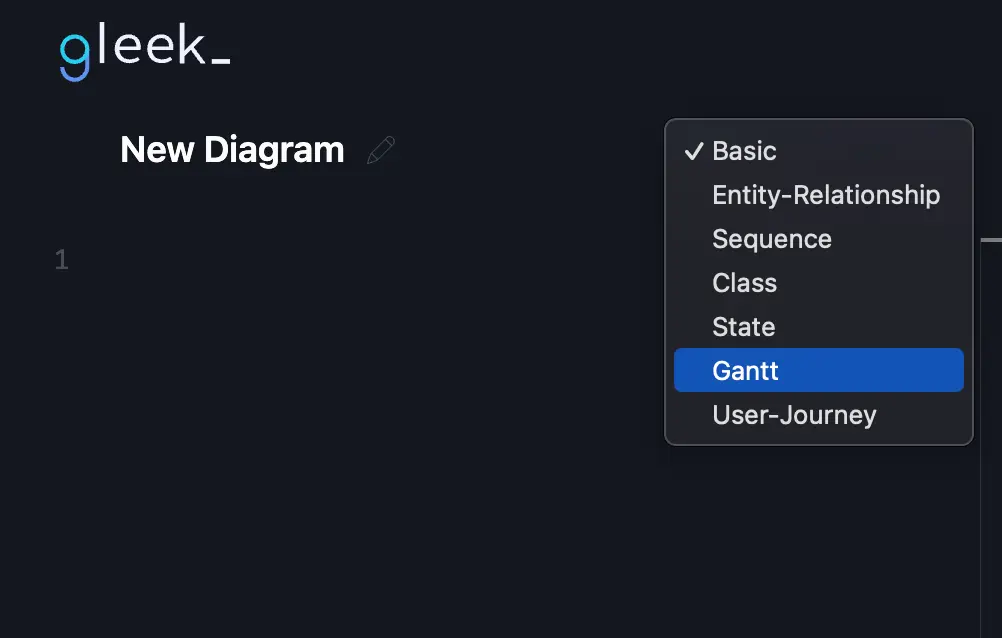
Step 2: Defining Research Goals
The research project initiates with an active phase dedicated to defining research goals, which commenced on December 15, 2023, lasting for a week. This phase involves brainstorming, outlining objectives, and establishing the research's overarching scope.

Step 3: Literature Review Phase
Transitioning to the next stage, we have the completed 'Literature Review' phase spanning two weeks. This phase entails an in-depth analysis, sourcing relevant publications, synthesizing existing knowledge, and aligning it with the predefined research goals.
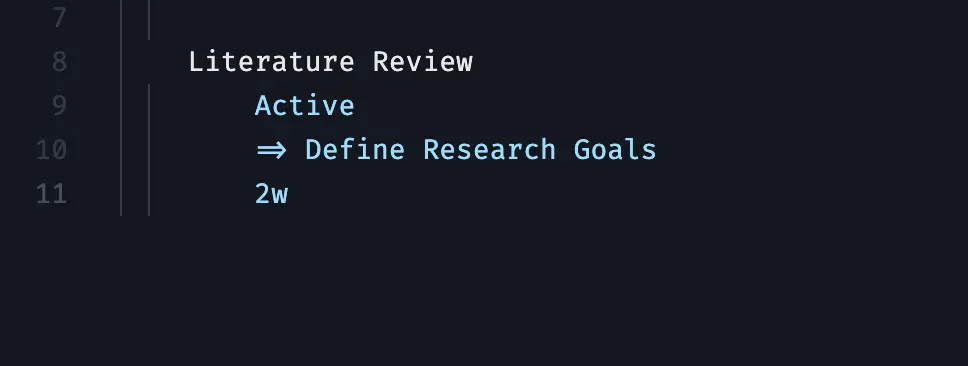
Step 4: Methodology Design Phase
Progressing to the 'Methodology Design' phase, currently active for three weeks, this stage intricately structures the research approach. It involves designing methodologies, frameworks, and strategies based on insights gleaned from the literature review, ensuring a robust research plan.

Step 5: Data Collection Phase
Following the planning stages is the critical 'Data Collection' phase, slated for four weeks. This phase involves meticulously gathering and assembling primary data, employing various methodologies such as surveys, experiments, or interviews, aligning with the established research framework.
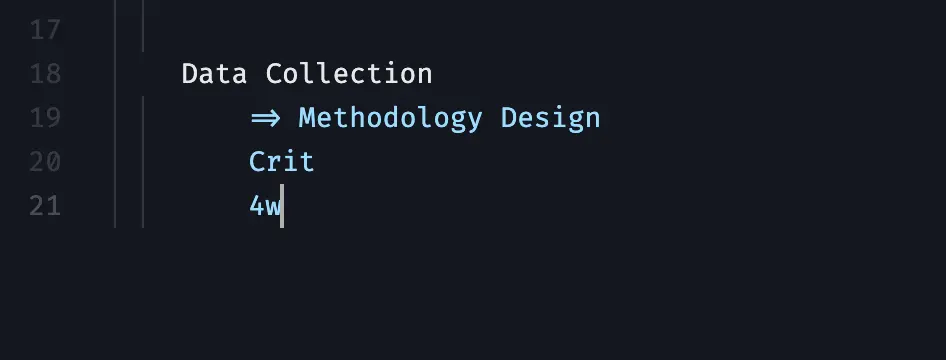

Step 6: Data Analysis Phase
Post-data collection, the active 'Data Analysis' phase spans three weeks. This phase engages in thorough data examination, statistical analysis, and deriving insights from the accumulated information. It involves identifying patterns, correlations, or trends relevant to the research objectives.

Step 7: Results Compilation Phase
Subsequently, the 'Results Compilation' phase consolidates and organizes the analyzed data over two weeks, presenting it in a coherent format. This phase involves preparing comprehensive reports, graphs, or summaries, showcasing the findings derived from the data analysis stage.
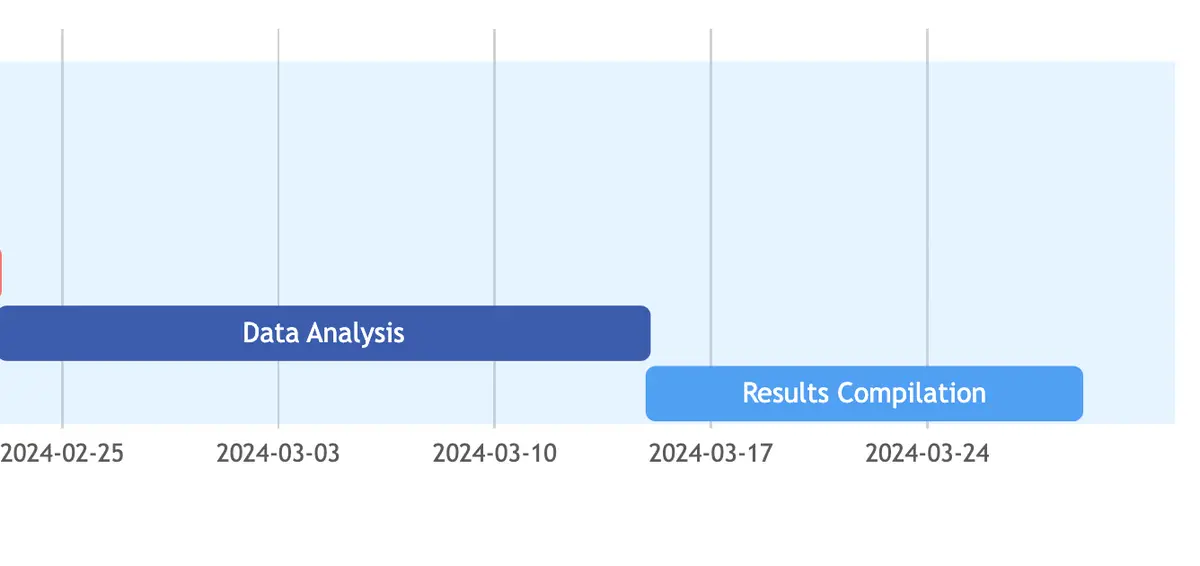
Step 8: Drafting Proposal Phase
Advancing further, the active 'Drafting Proposal' phase, extending over three weeks, involves crafting the research proposal. It includes outlining the research problem, detailing methodologies, and structuring a cohesive proposal aligned with the project's objectives.
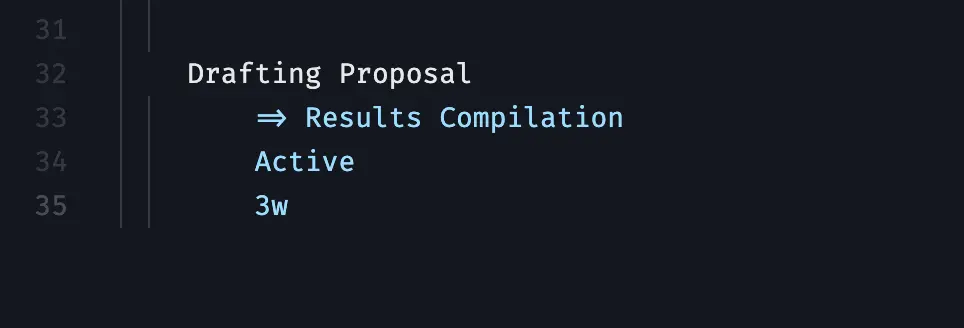
Step 9: Peer Review Phase
Upon completion of the draft, the two-week 'Peer Review' phase gathers insights and constructive feedback from peers or subject experts. It involves peer evaluations, discussions, and recommendations aimed at refining and enhancing the proposal's quality.
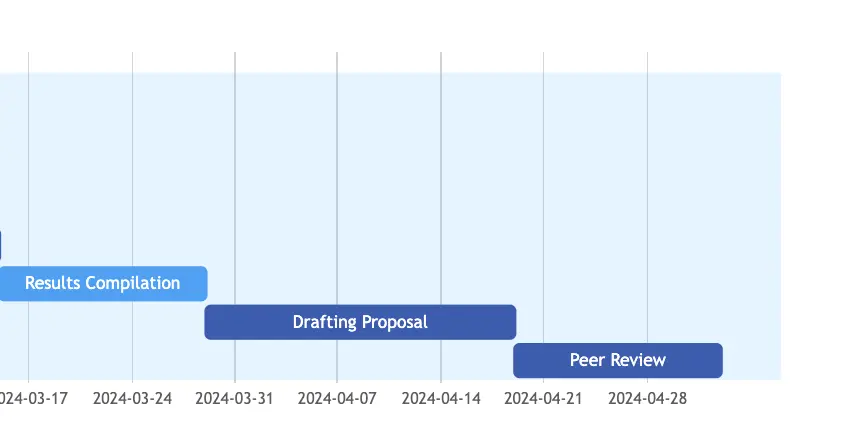
Step 10: Final Edits
Finally, the one-week active 'Final Edits' phase focuses on meticulous revisions, addressing feedback, and ensuring the proposal's completeness, accuracy, and compliance with set standards. This stage includes proofreading, formatting, and polishing the final document.

Step 11: Proposal Submission Milestone
The 'Proposal Submission' milestone, set for May 15, 2024, marks the conclusive stage, signifying the submission of the crafted and refined research proposal for evaluation and potential implementation.
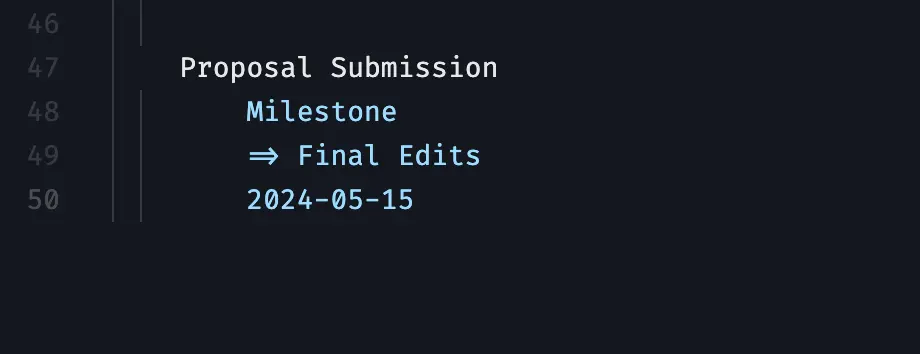
Hurray, You Did It!
And there you have it! Your Research Project Proposal Gantt Chart is now complete.

This comprehensive diagram, with its clearly defined stages, tasks, timeline, dependencies, resources, and status, provides a holistic view of your research project. It not only serves as a visual representation of the entire project but also acts as a roadmap guiding you from the initial brainstorming phase to the final proposal submission. Utilizing such a diagram can greatly enhance your project planning and execution, ensuring all aspects are considered, dependencies are taken into account, and milestones are tracked. It fosters better coordination, communication, and understanding among team members, leading to more efficient and effective project management.
About Gleek.io
Gleek.io is a powerful tool that can further enrich your project planning needs. It's an intuitive app designed to help you visualize complex ideas, processes, and systems through various types of diagrams. Whether you need to create a flowchart, UML diagram, or even a Gantt chart like the one we've just built, Gleek.io makes the process straightforward and hassle-free.
With its keyboard-centric approach, Gleek.io allows you to create diagrams faster than traditional drag-and-drop tools. You can quickly jot down your ideas and see them evolve into structured diagrams in real-time, making it an ideal tool for brainstorming sessions, project planning, and presentations.
In conclusion, Gleek.io is more than just a diagramming tool. It's a platform that enables you to visualize your thoughts, communicate complex ideas simply, and manage your projects more effectively. Give it a try for your next project and experience the difference it can make!
Related posts
Beyond Traditional Planning: Top Gantt Chart Alternatives in 2024
Gantt chart critical path explained
Visual project management: Gantt Charts vs. Timelines explained
Pert vs. Gantt Charts: Choosing your project's blueprint
back to all posts

- Mind Map Maker
- Concept Map Maker
- Bubble Map Maker
- Brace Map Maker
- Sunburst Chart Maker
- Timeline Maker
- Tree Diagram Maker
- Fishbone Diagram Maker
- Org Chart Maker
- Gantt Chart Maker
- Spider Diagram Maker
- Family Tree Maker
- EdrawMind AI
- AI Summarize
- AI Mind map
- AI Article generation
- AI Copywriting
- AI Translation
- -->> Strategy Planning
- -->> Note Taking
- -->> Brainstorming
- --> --> >--> -->